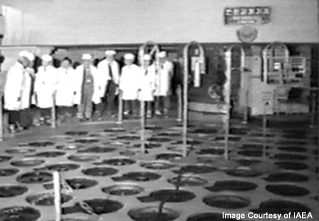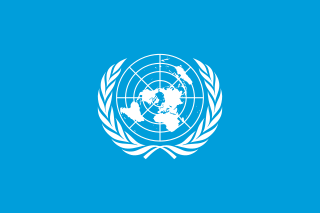 W
WNorth Korea has a military nuclear weapons program and, as of early 2020, is estimated to have an arsenal of approximately 30-40 nuclear weapons and sufficient production of fissile material for 6-7 nuclear weapons per year. North Korea has also stockpiled a significant quantity of chemical and biological weapons. In 2003, North Korea withdrew from the Treaty on the Non-Proliferation of Nuclear Weapons (NPT). Since 2006, the country has been conducting a series of six nuclear tests at increasing levels of expertise, prompting the imposition of sanctions.
 W
WThis chronology of the North Korean nuclear program has its roots in the 1950s and begins in earnest in 1989 with the end of the Cold War and the collapse of the Soviet Union, the main economic ally of North Korea. The Chronology mainly addresses the conflict between the United States and North Korea, while including the influences of the other members of the six-party talks: China, Russia, South Korea, and Japan.
 W
WThere have been a number of North Korean missile tests. North Korea has also fired a number of short-range missiles into the Sea of Japan, in what have been interpreted as political gestures.
 W
WA North Korean missile test occurred on May 29 and 30, 1993. North Korea fired a Nodong-1 missile into the Sea of Japan, from a base in Hwadae County near Wonsan, North Korea. The target was a buoy floating in the Sea of Japan. The North Koreans were testing the missile so they could export it to Iran in return for oil. Japanese and United States officials waited a few days before disclosing the launch of the missile. Afterwards, North Korea reaffirmed its commitment to the Nuclear Non-Proliferation Treaty.
 W
WTwo rounds of North Korean missile tests were conducted on July 5, 2006. The Democratic People's Republic of Korea reportedly fired at least seven separate missiles. These included one long-range Taepodong-2 missile and short-range Scud derived missiles including the enlarged Nodong missile. The Taepodong-2 was estimated by United States intelligence agencies as having a potential range reaching as far as Alaska, although this missile failed after about 42 seconds of flight.
 W
WTwo rounds of North Korean missile tests were conducted in July 2009. On July 4, 2009, the Democratic People's Republic of Korea launched seven short range missiles into the Sea of Japan, after previously launching four missiles two days earlier on July 2. The missiles were launched in violation of United Nations Security Council Resolution 1874.
 W
WThe 2013 North Korean missile tests were a series of North Korean missile tests in 2013.
 W
WThe 2014 North Korean missile tests were a series of North Korean missile tests in 2014.
 W
WThroughout 2017, 17 missile tests were conducted by North Korea. These tests ranged in success, and included first tests of the DPRK's new missile, the Hwasong-12, which was the most-tested missile type over the course of the year. 2017's missile tests are especially notable due to the several instances of North Korean missiles passing over Japan, provoking a response from the Japanese government, as well as the test of an ICBM, the range of which prompted an Emergency Debate of the UN Security Council.
 W
WThe Agreed Framework between the United States of America and the Democratic People's Republic of Korea was signed on October 21, 1994, between North Korea (DPRK) and the United States. The objective of the agreement was the freezing and replacement of North Korea's indigenous nuclear power plant program with more nuclear proliferation resistant light water reactor power plants, and the step-by-step normalization of relations between the U.S. and the DPRK. Implementation of the agreement was troubled from the start, but its key elements were being implemented until it effectively broke down in 2003.
 W
WThe Japan–North Korea Pyongyang Declaration was signed in 2002, and was the result of a systematic Japan–North Korea summit meeting. The aim of the declaration was to provide low-interest long term loans to North Korea as well as economic assistance, including humanitarian aid, in accordance with the moratorium of nuclear missile development which has been in place since 1999. The Japanese government hoped to learn the fate of Japanese citizens by North Korea which, prior to the declaration, was unacknowledged.
 W
WThe Korean conflict is an ongoing conflict based on the division of Korea between North Korea and South Korea, both of which claim to be the sole legitimate government of all of Korea. During the Cold War, North Korea was backed by the Soviet Union, China, and other allies, while South Korea was backed by the United States and its Western allies.
 W
WNorth Korea (DPRK) has been active in developing nuclear technology since the 1950s.
 W
WThe Nyongbyon Nuclear Scientific Research Center is North Korea's major nuclear facility, operating its first nuclear reactors. It is located in Nyongbyon County in North Pyongan Province, about 100 km north of Pyongyang. The center produced the fissile material for North Korea's six nuclear weapon tests from 2006 to 2017, and since 2009 is developing indigenous light water reactor nuclear power station technology.
 W
WPunggye-ri Nuclear Test Site was the only known nuclear test site of North Korea. Nuclear tests were conducted at the site in October 2006, May 2009, February 2013, January 2016, September 2016, and September 2017.
 W
WThe Ryanggang explosion was a large explosion that took place in North Korea on 9 September 2004 in the northern province of Ryanggang. The nature and cause of the suspected explosion is the subject of speculation. No neighboring nations have claimed any detection of radioactive isotopes characteristic of a nuclear explosion.
 W
WSohae Satellite Launching Station is a rocket launching site in Tongch'ang-ri, Cholsan County, North Pyongan Province, North Korea. The base is located among hills close to the northern border with China. The spaceport was built on the site of the village Pongdong-ri which was displaced during construction. It was the site for the 13 April 2012 launch of the North Korean satellite Kwangmyŏngsŏng-3, which was launched to celebrate the 100th anniversary of the birth of Kim Il-Sung. The rocket launch failed, but on 12 December of the same year Kwangmyŏngsŏng-3 Unit 2 was successfully launched and brought into Earth orbit.
 W
WThe Tonghae Satellite Launching Ground, also known as Musudan-ri, is a rocket launching site in North Korea.
 W
WUnited Nations Security Council resolution 825, adopted on 11 May 1993, called upon the Democratic People's Republic of Korea to reconsider its decision to withdraw from the Nuclear Non-Proliferation Treaty and allow weapons inspectors from the International Atomic Energy Agency (IAEA) into the country, after it had previously refused entry.
 W
WUnited Nations Security Council Resolution 1695, adopted unanimously on July 15, 2006, after recalling resolutions 825 (1993) and 1540 (2004) concerning North Korea and the non-proliferation of weapons of mass destruction respectively, the Council banned the selling of material that would further the ability of the Democratic People's Republic of Korea to bolster its ballistic missiles programme.
 W
WUnited Nations Security Council Resolution 1718 was adopted unanimously by the United Nations Security Council on October 14, 2006. The resolution, passed under Chapter VII, Article 41, of the UN Charter, imposes a series of economic and commercial sanctions on the Democratic People's Republic of Korea in the aftermath of that nation's claimed nuclear test of October 9, 2006.
 W
WUnited Nations Security Council Resolution 1874 was adopted unanimously by the United Nations Security Council on 12 June 2009. The resolution, passed under Chapter VII, Article 41, of the UN Charter, imposes further economic and commercial sanctions on the Democratic People's Republic of Korea and encourages UN member states to search North Korean cargo, in the aftermath of an underground nuclear test conducted on 25 May 2009.
 W
WUnited Nations Security Council Resolution 1928, adopted unanimously on June 7, 2010, after recalling resolutions 825 (1993), 1540 (2004), 1695 (2006), 1718 (2006), 1874 (2009) and 1887 (2009) on the topics of North Korea and nuclear weapons, the Council extended the mandate of a panel of experts monitoring sanctions against the country until June 12, 2011.
 W
WUnited Nations Security Council Resolution 1985, adopted unanimously on June 10, 2011, after recalling resolutions 825 (1993), 1540 (2004), 1695 (2006), 1718 (2006), 1874 (2009), 1887 (2009), 1928 (2010) on the topics of North Korea and nuclear weapons, the Council extended the mandate of an expert panel monitoring sanctions against the country until June 12, 2012.
 W
WUnited Nations Security Council Resolution 2087, adopted unanimously on January 22, 2013, after recalling all previous relevant resolutions on the situation concerning North Korea, including resolutions 825 (1993), 1540 (2004), 1695 (2006), 1718 (2006), and 1874 (2009), the Council condemned the December 12, 2012 rocket launch by the Democratic People's Republic of Korea. North Korea cited this resolution as the cause of the 2013 Korean crisis.
 W
WOn March 4, 2015, the United Nations Security Council unanimously adopted Resolution 2207 on North Korea. The resolution extended the mandate of the Panel of Experts, which supports activities of the ‘1718 Sanctions Committee’, for one year to April 5, 2016.
 W
WThe United Nations Security Council unanimously adopted Resolution 2270 on March 2, 2016, with approval of all the five permanent members and the ten non-permanent members in response to North Korea’s fourth nuclear test on January 6, 2016, and its launch of a long-range missile carrying what it said was a satellite on February 7, 2016.
 W
WThe United Nations Security Council unanimously adopted Resolution 2371 on August 5, 2017, with approval of all the five permanent members and the ten non-permanent members in response to North Korea’s July 2017 missile tests.
 W
WUnited Nations Security Council Resolution 2375 was adopted on 11 September 2017. The United Nations Security Council unanimously adopted a new sanctions resolution against North Korea, a response to its sixth nuclear test on September 3. The resolution reduces about 30% of oil provided to North Korea by cutting off over 55% of refined petroleum products going to North Korea.
 W
WUnited Nations Security Council Resolution 2397 is a resolution adopted unanimously on 22 December 2017 in response to North Korea's launch of a Hwasong-15 intercontinental ballistic missile on 28 November of that year. The resolution condemned the launch and further tightened sanctions on the country, restricting fuel imports and other trade, as well as the ability of North Korean citizens to work abroad. On 24 December, the North Korean Ministry of Foreign Affairs stated that the resolution constitutes an act of war.